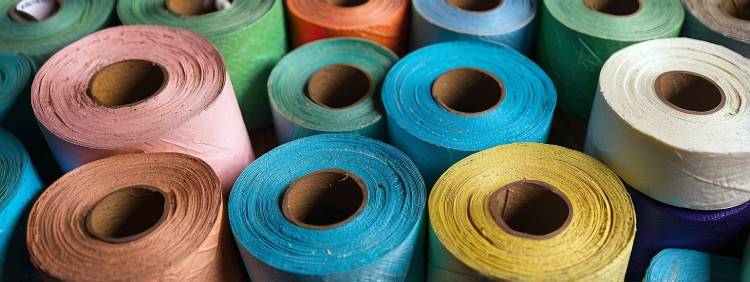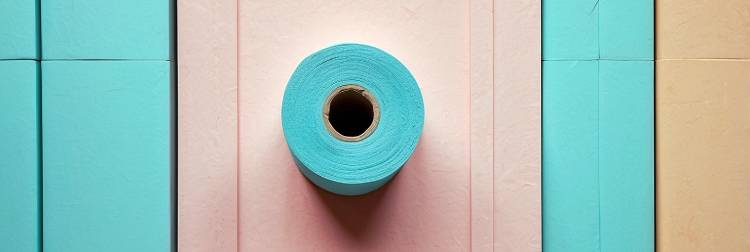Have you ever wondered why you can’t find colored toilet paper on store shelves anymore? Remember the days when you could match your toilet paper to your bathroom’s décor, with shades of pink, blue, and even green?
Nowadays, it seems like white is the only option.
In this article, we’ll explore the reasons behind this shift, examining the factors that led to the disappearance of colored toilet paper. We’ll also look at the environmental, health, and market trends that have influenced this change.
By the end, you’ll have a clear understanding of why colored toilet paper has become a thing of the past and what it means for us as consumers.
A Flashback To The Rainbow Rolls

Think back to the ’70s and ’80s—those vibrant decades when bold colors were everywhere, including the bathroom. Colored toilet paper was a popular choice, allowing people to coordinate their bathroom accessories with their towels, shower curtains, and even the tiles.
It wasn’t just about aesthetics; it was about expressing personal style. But as the years went by, colored toilet paper started to vanish from the shelves, leaving many of us scratching our heads.
Reasons Why Colored Toilet Paper Are No More
- The Environmental Impact
One of the primary reasons for the decline of colored toilet paper is its environmental impact. Producing colored toilet paper involves using dyes and chemicals that aren’t exactly eco-friendly.
In recent years, there’s been a significant shift towards more environmentally conscious products. Consumers are more aware than ever of the impact their choices have on the planet, and this awareness has driven demand for more sustainable options.
White toilet paper, in contrast, can be produced using fewer chemicals. The bleaching process has also become more environmentally friendly over time, with many manufacturers using processes that are less harmful to the environment.
By choosing white toilet paper, consumers are making a small but meaningful contribution to reducing their ecological footprint.
- Health Concerns
Another factor that contributed to the disappearance of colored toilet paper is health concerns. The dyes used in colored toilet paper can sometimes cause allergic reactions or skin irritation, especially for people with sensitive skin.
While these reactions might not be common, they are enough to deter health-conscious consumers from choosing colored options.
In addition, there have been concerns about the potential long-term health effects of exposure to the chemicals used in these dyes. While there’s no definitive evidence linking colored toilet paper to serious health issues, the potential risks have been enough to push both consumers and manufacturers towards safer, dye-free options.
- Market Trends and Consumer Preferences
Consumer preferences play a significant role in determining what products are available on the market. Over the years, there has been a noticeable shift towards minimalism and simplicity in home decor.
This trend extends to bathroom accessories, where neutral colors and clean designs are favored over bold, vibrant hues. White toilet paper fits perfectly into this aesthetic, offering a clean, simple look that complements any bathroom style.
Additionally, white toilet paper is perceived as more hygienic and pure. The association of white with cleanliness and purity has reinforced the preference for white toilet paper over colored alternatives.
As a result, manufacturers have adapted to meet this demand, gradually phasing out colored options in favor of the more popular white variety.
- Cost and Production Efficiency
From a manufacturing perspective, producing white toilet paper is more cost-effective and efficient. The process of adding color to toilet paper involves additional steps and materials, which increase production costs.
By eliminating these extra steps, manufacturers can streamline their production processes and reduce costs. These savings can then be passed on to consumers, making white toilet paper a more affordable option.
Moreover, the demand for colored toilet paper has decreased significantly over the years. With fewer consumers seeking out colored options, it doesn’t make economic sense for manufacturers to continue producing them.
Instead, they focus on meeting the demand for white toilet paper, which is now the standard choice for most households.
Nostalgia Vs. Practicality

While some of us may feel a sense of nostalgia for the days of colored toilet paper, practicality has taken precedence. The benefits of white toilet paper, from environmental and health considerations to cost and production efficiency, have outweighed the aesthetic appeal of colored options.
In today’s world, where sustainability and health are top priorities for many consumers, it’s easy to see why white toilet paper has become the norm.
The Future of Toilet Paper
So, what does the future hold for toilet paper? While it’s unlikely that colored toilet paper will make a significant comeback, there are exciting developments in the world of toilet paper.
Manufacturers are continuously exploring ways to make their products more sustainable, such as using recycled materials and reducing packaging waste.
There is also a growing interest in alternative products like bamboo toilet paper, which is praised for its eco-friendly properties.
Bamboo grows quickly and requires fewer resources to produce, making it a more sustainable option compared to traditional wood pulp. As more consumers become aware of these alternatives, we may see a shift towards even more environmentally friendly options in the future.
Final Thoughts
In conclusion, the disappearance of colored toilet paper can be attributed to a combination of environmental, health, and market factors. As consumers, our preferences have evolved towards more sustainable, health-conscious, and cost-effective products.
While colored toilet paper may hold a certain nostalgic charm, the practical benefits of white toilet paper have made it the preferred choice for most households. By understanding these factors, we can make more informed decisions about the products we use and contribute to a more sustainable future.
Now that we’ve explored the reasons behind the decline of colored toilet paper, you can appreciate why those vibrant rolls are no longer a common sight. Whether you’re a fan of the classic white or interested in exploring new sustainable options, the choice is yours.
The next time you reach for a roll of toilet paper, you’ll have a deeper understanding of the factors that shaped its journey from colorful to classic.
